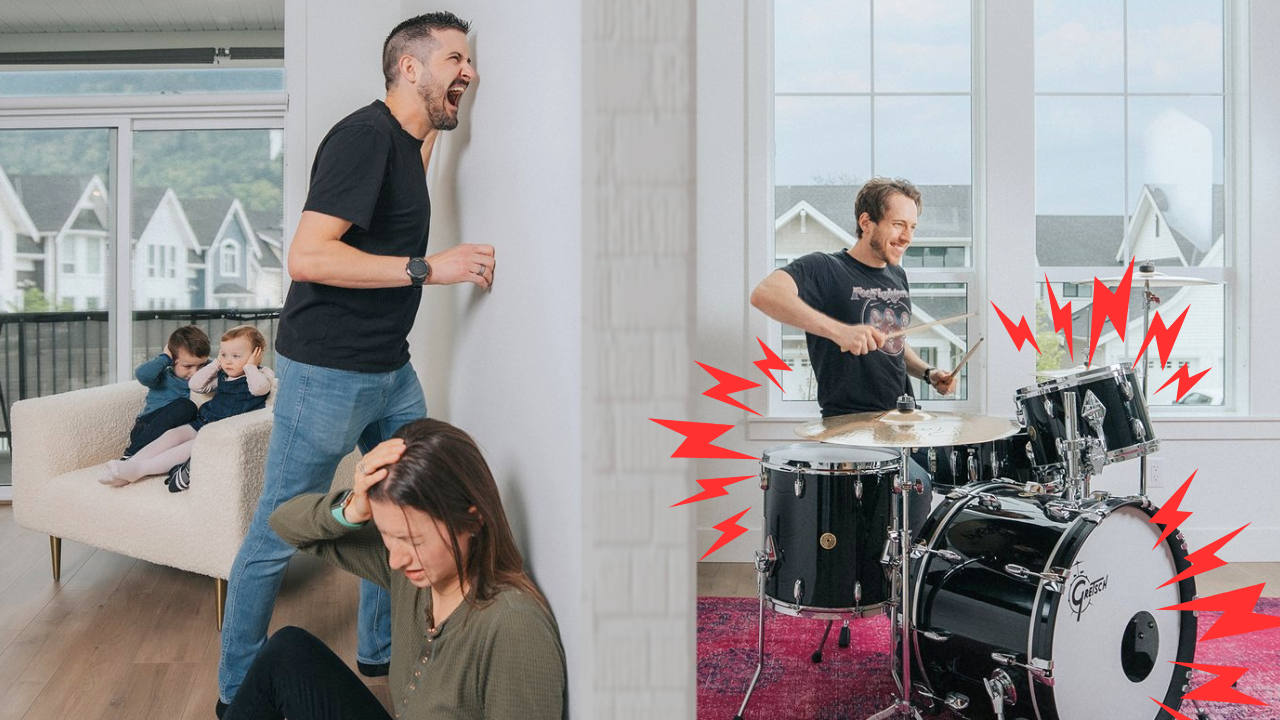By constantly working on your skills as a drummer, you get better and better. However, what if you have a regular job in the daytime and can drum only in late hours? In this case, you definitely need to care for specially designed tools for late-night drumming or warming up in the hotel. Let’s explore what you need to have for this purpose.
Sound-Off Tools
These are tools that can be installed on your drum kit, allowing you to practice in your real drum setting but with less noise. Such tools feature cymbal mutes (rubber plates) and sound-off pads – both are available in various sizes. Although rubber plates and sound-off pads don’t provide 100% perfect quiet practice they do reduce sound.
Their installation is straightforward: you just place the rubber plates onto your hi-hat, crash or ride cymbal. The kick drum pad is attached to the rim with clamps on both sides. Typically installation takes several minutes.
Once it’s done, you can enjoy a comfortable practice session in your natural drumming environment without bothering your neighbours or family late at night and killing your own ears with noise.

Low-Budget Quiet Drumming Practice Tools
These are not actually tools but tricks used by drummers who want to arrange their set for comfortable late-night drumming without spending too much money. What they do is use heavyweight blankets to throw them over an acoustic drum kit.
While it may look like a very good idea, there are some drawbacks. Very often the wish to get an effective dampening ends up with using very thick blankets that can make it difficult to play. This can even increase the risk of damage. If you want to try this method, make sure that you use lighter coverings which can offer you a good degree of rebound.
A Practice Pad Kit
Such kits typically feature a set of drum pads attached to a central shaft with a pad for a bass drum pedal at the bottom. All those things are installed on a tripod allowing you to easily arrange your kit in any setting to start practicing.
The good news is that such kits don’t cost much, while offering you an excellent portable solution to play really quietly. Pads featured in these kits also offer you more rebound.
What drummers may not like so much about this construction is that it’s shaky. For players who used to hit hard, it may not be the best option as the kit will likely not serve long.

The Secret is in Combination of Things
Some drumming bloggers believe that despite having many options for quiet practice on drums available on the market, you need to combine things to get the best result.
Sound-Off Pads vs. Mesh Drumheads vs. Quiet-Tone Pads
Drummers find sound-off pads the best option for tom drums as they allow them to sound actually like tom drums, while mesh drumheads may make them slippery despite their good sound. With rubber sound-off pads, drummers have less mess with sticks sliding around. What’s more, they really get the feel of the workout they are looking for.
While drummers feel rather satisfied with sound-off pads for tom drums, they have a hard time selecting the perfect option for a snare drum. The thing is that for many players an awful snare sound can really destroy the overall desire to play.
Many drummers find mesh drumheads for a snare drum not the best option as it results in bad response from the sticks. Some also say “no” to rubber pads as well as they also provide hideous sound.

What do they use then? They prefer an alternative — quiet-tone practice pads, specially designed over-the-snare drum muted devices with feet on the underside allowing them to comfortably be installed on the drumhead.
Compared to meshed heads and sound-off rubber pads, they offer a better sound while reducing the volume. Their coated head provides players with a real drum feel and good stick response. Moreover, these quiet-tone practice pads offer adjustable tension that lets you control the response and feel. They may not provide the best rim sound, but it still works well for quiet practice at home.
For a bass drum, musicians may use Japanese hand wipes taped on the drum and folded up inserts for a cymbal bag placed to touch the bass drumhead in order to reduce overtones. For quieter drum practice musicians also replace traditional beaters with spongy kids soccer balls with drilled holes. They may also use some padding on the front side of the bass drum to muffle the sound.
Although many drummers use rubber pads for cymbals, there are individuals who also find them not the perfect option. This is especially true for jazz drummers as they admit that rubber plates don’t provide the real feel of playing cymbals. Instead they use low volume cymbals producing 20% of normal cymbals’ volume.
Final Word
There are many ways to make your drumming quieter and thus help you avoid confrontation with your family and neighbors. You can use things which you have in your home — such as blankets or towels, buy mesh drumheads, rubber pads or low volume cymbals. There are plenty of offerings and many ways to combine them. Since there is no one-size-fits-all option, you can’t decide what works for you unless you try several different methods.
Would you like to have a look at our full collection of gear? You can find many useful things in our category of High-Quality Accessories for Drummers.
If you’re just starting your journey, check out our article featuring a list of essential accessories for drummers.



 https://kgumusic.com/pages/about-us
https://kgumusic.com/pages/about-us